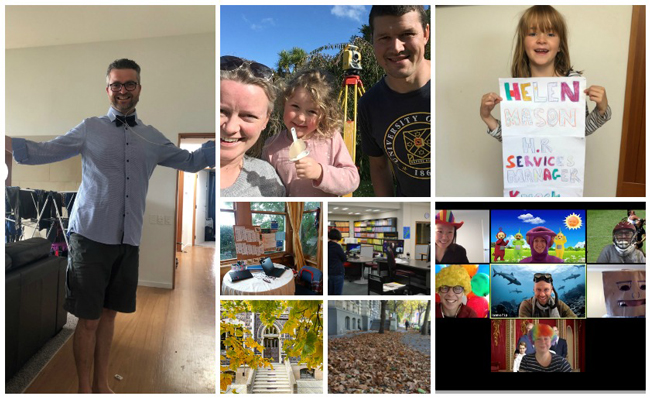Thursday 2 July 2020 11:25pm

A small selection of some of the many images already in Otago's digital time capsule which, when looked through, begin to paint a picture of life through COVID-19. Do you have a photo you would like to contribute?
An informal digital time capsule offering a snapshot of University of Otago activity and experiences during the COVID-19 pandemic is now available to view – and contribute to.
The site has been put together by a team led by Pro-Vice-Chancellor (Humanities) Professor Tony Ballantyne, who says we are living through a rapid and far reaching transformation of our society.
“For most of it’s the first experience of the impact of a pandemic in our lifetime. There’s a really interesting set of human stories to tell and record and this repository will house some of them,” he says.
"I’d like to encourage everyone throughout the University community to think about making some kind of contribution to the archive whether its photo of their home workstation, a screenshot of a Zoom meeting or a photo of their return to the office."
Professor Ballantyne says the digital repository is an opportunity to record the transformation of an institution in a time of rapid social change at a public health level.
“Literally overnight the way the University operated was fundamentally changed. Building this archive is an opportunity for us as a community of learning to document those shifts. But it will also have great value for future generations who might have a connection to our University or future researchers to think about the ways that COVID-19 impacted society and education.
“I’d like to encourage everyone throughout the University community to think about making some kind of contribution to the archive whether its photo of their home workstation, a screenshot of a Zoom meeting or a photo of their return to the office. Each and every contribution will enhance this record of how our working lives have been changed so profoundly."
Professor Ballantyne says he plans to deposit all the messages that he sent to the Humanities Division over the early days of the lockdown.
“We want to capture the texture of our changing lives under lockdown.”
Professor Ballantyne added that a lot of credit for the project needs to go to Stephen Willis for championing it.
“Universities are complex institutions where change often happens slowly because our processes often involve many, many people and a lot of debate and consultation. And what’s happened in the last few months is really rapid change. Normally when we change processes in the University it takes at least two years, we’ve been redesigning processes in a matter of days or sometimes weeks, and that’s quite remarkable.”
"As an historian I often think about how time is lumpy, you can have long stretches of human history where things don’t change much and some moments such as we have just experienced where change is intensified and really accelerated."
Professor Ballantyne believes that some of those changes will be really short lived, but some will shape the future contours of the institution for a very long time.
“Last year we marked 150 years of the University and it was a tremendous occasion to reflect on the development of the institution. In the past few months all of our students and staff have had to work through a profoundly challenging set of circumstances. So, it’s a very important time to both look back and to think about the University’s future.
“As an historian I often think about how time is lumpy, you can have long stretches of human history where things don’t change much and some moments such as we have just experienced where change is intensified and really accelerated.
“Some people have found real positives in different ways of working and for others it has been really disruptive and a hard thing to live through. For us to capture and reflect on that range of experiences is a very important thing.
“I would expect that submissions will continue to come through especially as our staff return to work and some kind of normality. They can reflect on something that they can contribute to the digital repository,” Professor Ballantyne says.
At the time of writing the digital time capsule housed a wide array of items including 89 photos, 18 media related pieces, 15 videos, 11 stories, seven documents, and four poems.
Story by Kerry Dohig (Communications Adviser, Enabling Excellence).
